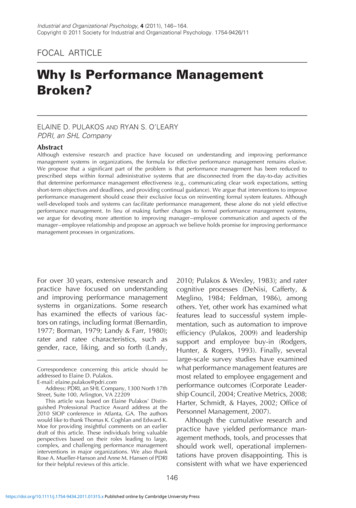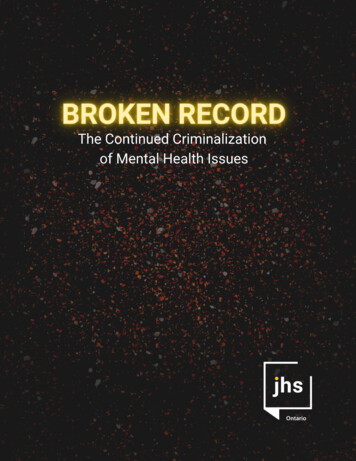
Transcription
Industrial and Organizational Psychology, 4 (2011), 146–164.Copyright 2011 Society for Industrial and Organizational Psychology. 1754-9426/11FOCAL ARTICLEWhy Is Performance ManagementBroken?ELAINE D. PULAKOS AND RYAN S. O’LEARYPDRI, an SHL CompanyAbstractAlthough extensive research and practice have focused on understanding and improving performancemanagement systems in organizations, the formula for effective performance management remains elusive.We propose that a significant part of the problem is that performance management has been reduced toprescribed steps within formal administrative systems that are disconnected from the day-to-day activitiesthat determine performance management effectiveness (e.g., communicating clear work expectations, settingshort-term objectives and deadlines, and providing continual guidance). We argue that interventions to improveperformance management should cease their exclusive focus on reinventing formal system features. Althoughwell-developed tools and systems can facilitate performance management, these alone do not yield effectiveperformance management. In lieu of making further changes to formal performance management systems,we argue for devoting more attention to improving manager–employee communication and aspects of themanager–employee relationship and propose an approach we believe holds promise for improving performancemanagement processes in organizations.For over 30 years, extensive research andpractice have focused on understandingand improving performance managementsystems in organizations. Some researchhas examined the effects of various factors on ratings, including format (Bernardin,1977; Borman, 1979; Landy & Farr, 1980);rater and ratee characteristics, such asgender, race, liking, and so forth (Landy,Correspondence concerning this article should beaddressed to Elaine D. Pulakos.E-mail: elaine.pulakos@pdri.comAddress: PDRI, an SHL Company, 1300 North 17thStreet, Suite 100, Arlington, VA 22209This article was based on Elaine Pulakos’ Distinguished Professional Practice Award address at the2010 SIOP conference in Atlanta, GA. The authorswould like to thank Thomas K. Coghlan and Edward K.Moe for providing insightful comments on an earlierdraft of this article. These individuals bring valuableperspectives based on their roles leading to large,complex, and challenging performance managementinterventions in major organizations. We also thankRose A. Mueller-Hanson and Anne M. Hansen of PDRIfor their helpful reviews of this article.2010; Pulakos & Wexley, 1983); and ratercognitive processes (DeNisi, Cafferty, &Meglino, 1984; Feldman, 1986), amongothers. Yet, other work has examined whatfeatures lead to successful system implementation, such as automation to improveefficiency (Pulakos, 2009) and leadershipsupport and employee buy-in (Rodgers,Hunter, & Rogers, 1993). Finally, severallarge-scale survey studies have examinedwhat performance management features aremost related to employee engagement andperformance outcomes (Corporate Leadership Council, 2004; Creative Metrics, 2008;Harter, Schmidt, & Hayes, 2002; Office ofPersonnel Management, 2007).Although the cumulative research andpractice have yielded performance management methods, tools, and processes thatshould work well, operational implementations have proven disappointing. This isconsistent with what we have 2011.01315.x Published online by Cambridge University Press
Why is performance management broken?as we implemented many large-scale performance management systems over thepast 15 years. For example, no solutionhas been found to ameliorate the seeminglyintractable problem of leniency in ratings,which at the extreme renders performanceevaluations of little value for decision making (e.g., pay, promotion, etc.) or validation research. Although implementationof a new performance management system is usually accompanied by decreasedleniency during the initial rating cycle, rating levels creep up again over time. Asanother example, survey data consistentlyshow poor attitudes toward performancemanagement, with many employees reporting that their system fails to provide usefulfeedback and establish clear expectations.Thus, after extensive analysis and study, theformula for effective performance management remains elusive.It is perhaps for this reason that performance management has been characterized by innumerable attempts to improveit, more so than it seems to be the casewith other human capital systems. In thelast 20 years, recommendations have beenmade to evaluate results, competencies,behaviors, and contributions; to rate performance using highly differentiated 5-, 7-,or 9-point scales, much simpler pass–failscales, strictly developmental scales, or noscales and instead prepare written narratives; to collect ratings from supervisors,peers, customers, or the employees themselves; to cascade goals from the highestorganizational level to individual employees, to establish individual’s objectives thatare rated directly, or not to include goals;and the list goes on. As long as a newapproach holds promise for increasing performance management effectiveness, organizational members from top-level leadersto human resource professionals seem toflock to it. What happens so often, however, is that new performance managementpractices are enthusiastically and readilyadopted, without sufficient consideration ofwhat it takes to implement them effectivelyor how they will fit within an organization’s culture (Pulakos, 2009). This has led147to vicious cycles of organizations reinventing their performance management systemsevery few years only to suffer implementation failures that necessitate reinventing thesystem again, and the cycle continues.The challenges inherent in performancemanagement are well known. It has rightlyearned its distinction as the ‘‘Achilles Heel’’of human capital management, rarely working well irrespective of the time, effort, andresources that are devoted to it. Yet, communicating what employees are expectedto do, providing feedback, and helpingemployees contribute the most they can areessential behaviors managers must engagein to accomplish work through others. Doneeffectively, performance management communicates what’s important to the organization, drives employees to achieve results,and implements the organization’s strategy.Done poorly, performance management notonly fails to achieve these benefits but canalso undermine employee confidence anddamage relationships. The extremely largenumber of unsuccessful attempts to improveperformance management speaks volumesabout its inherent difficulties.We believe that a significant part ofthe problem is that performance management has been reduced to prescribed, oftendiscrete steps within formal administrativesystems, the results of which are highlyscrutinized. Although formal performancemanagement systems are intended to driveand reinforce the day-to-day activities ofcommunicating ongoing expectations, setting short-term objectives, and giving continual guidance as work is planned andexecuted, these behaviors seem to havebecome largely disconnected from the formal systems. For example, effective managers regularly provide informal feedback toemployees on specific tasks, but the samemanagers are often reluctant to formallydocument less-than-stellar performance forfear of damaging relationships with the veryindividuals they count on to get the workdone. Similarly, many employees wantguidance from their managers about howto accomplish work, yet they do not wantdocumented examples of them 315.x Published online by Cambridge University Press
E.D. Pulakos and R.S. O’Leary148guidance for fear that these will underminetheir pay or advancement. These concernson the part of managers and employeesprevent formal performance managementsystems from working well and have turnedthem into largely administrative drills thatadd little value. Contributing to this is thefact that performance management implementations tend to focus on rolling outformal administrative processes and tools(e.g., competency models, rating scales,and automated systems) rather than trainingmanagers and employees how to engage ineffective performance management behavior (e.g., setting expectations, providingfeedback, and helping staff solve problems). However, it is the informal processof engaging in these behaviors day-to-daythat determines performance managementeffectiveness, not the tools and steps thatcomprise the formal system.In this article, we argue for a shift in thefocus of performance management interventions in two important ways. First, webelieve unbridled implementation of performance management system changes shouldcease. This is because making changes tothe formal performance management system has not been shown to improve performance management effectiveness. Further, implementing new practices that seemcompelling but are difficult or impractical to sustain can cause negative consequences, such as eroded credibility andincreasingly negative attitudes towards performance management. To illustrate thesepoints, we provide examples of the difficulties involved in implementing fourpopular performance management practices below. The second shift we proposeis to devote more attention to improvingmanager–employee communication andaspects of the manager–employee relationship that are foundational for effective performance management. Althoughwell-developed tools and systems can facilitate performance management, these alonedo not yield effective performance management, as this can only occur betweenpeople. We thus propose an approach forenhancing manager–employee communication and relationships that we believeholds promise for yielding sustainable performance management improvement.What It Takes to ImplementFour Popular PerformanceManagement PracticesPopular Practice 1: CascadeOrganizational Goals toIndividual EmployeesOne of today’s popular performance management practices is to cascade organizational goals from the top and refine themthrough each level until they reach individual employees. The idea of linking objectives across organizational levels dates backmany decades to discussions of managingby objectives (Rodgers & Hunter, 1991).Proponents of cascading goals argue thatthey help everyone understand how workis related across organizational units andlevels, and they also align the work ofindividuals and units with the organization’s direction and priorities (Hillgren &Cheatham, 2000; Schneier, Shaw, & Beatty,1991). Although understanding these relationships is important and helps to avoidconfusion, redundancy, and turf battles,there are questions as to whether or nota formal process of cascading goals is themost effective way to achieve this.Although the rationale underlying cascaded goals makes sense, creating thecascade itself is extremely challenging operationally. First, high-level organizationalgoals are often lofty and broad, whichoften causes confusion and frustration whenmanagers attempt to cascade them. Second, the process of cascading goals throughmultiple levels necessitates many meetingsthat are contingent on the previous levelcompleting their cascade. As a practicalmatter, although the organization and perhaps its largest divisions may have goals,it has been our experience that cascadedgoals rarely reach past the highest few levels. Thus, it can take months of work wellinto the performance management 5.x Published online by Cambridge University Press
Why is performance management broken?149Table 1. Popular Practice 1: Cascade Organizational Goals to Individual EmployeesProponents advocate Cascade goals so that each level supportsgoals relevant to the prior higher level Help employees gain an understanding ofhow their work relates to higher levels Align the employee’s activities with theorganization’s strategic direction and goalsbefore individual objectives can be written, although the process becomes moreefficient after it has been completed once.Given that less than 10 hours per year,on average, is devoted to performance management activities per employee (Brentz,Milkovich, & Read, 1992), the decisionto implement a formal cascade must bemade with a corresponding commitmentto devote significantly more time to performance management activities. Becausethe process of cascading goals is difficultand burdensome to execute well, it oftencollapses under its own weight. Althoughtraining managers how to cascade goals ishelpful, facilitated sessions with trained professionals yield higher quality cascades withless frustration and wheel spinning thanwhen organizational members attempt tocascade goals on their own. In lieu of a formal cascade, informal discussions amongleaders, managers, and employees can beequally useful in gaining a common understanding of direction, roles, and boundariesso that work can proceed in an organizedmanner.Bottom line recommendation regardingcascaded goals. In light of the complexity,practical implementation challenges, andpotential risk for failure, we do not recommend that cascaded goals be implementedin the vast majority of organizations. If theReality Organizational goals can be lofty anddifficult to cascade down to individuals It is time consuming and difficult to cascadegoals, especially the first time Considerable consultant or HR time isneeded to facilitate the cascade If employees do not attach a high value tocascaded goals, the burdensome processwill be frustrating and yield negativeattitudes The advantages associated with cascadinggoals can be achieved through moreinformal and simpler communicationprocessespractitioner or organizational decision makers believe that there is an organizationalissue or problem that is best addressedby cascaded goals, they should be implemented only if commitment to the resourcesand time that are necessary to achieve quality results can be secured from all involvedparties (Table 1).Popular Practice 2: Set SMARTPerformance GoalsA popular practice today is to evaluateperformance based on whether employeesmeet SMART (specific, measurable, attainable, relevant, time-bound) goals developed at the beginning of the rating cycle.The stated advantages of the goals are to(a) provide customized performance expectations and criteria based on the employee’sspecific job, (b) drive employees to achieveimportant results, and (c) remove unfairsubjectivity from the evaluation process.Although it is certainly important for managers to communicate what they expecteach employee to achieve, it is not clearthat setting formal goals for each employeeis the most effective way to accomplishthis or that this is even viable for alljobs. Even when well-researched guidelines(Locke & Latham, 1990) for setting goalshave been used, significant challenges .x Published online by Cambridge University Press
E.D. Pulakos and R.S. O’Leary150been reported (e.g., Government Accountability Office, 2008).Jobs that lend themselves best to setting goals have relatively static performancerequirements and defined productivity metrics, for example, many manufacturingjobs. However, setting goals for today’sincreasingly knowledge and service-basedjobs is more challenging. The fluidand unpredictable nature of these jobsmeans that one’s objectives can changefrequently, necessitating continual revision and increasing the work associatedwith performance goals (Cascio, 1998;Pulakos, Mueller-Hanson, & O’Leary, 2008;Pulakos & O’Leary, 2010). Even when jobsare relatively predictable, goals set at thestart of the performance cycle often cannotaccount for special assignments or otherduties that may arise during the year. Goalsalso do not work well when goal attainment is dependent on factors outside theemployee’s control or that are team oriented(Lawler, 1994; Locke & Latham, 1990; Ployhart & Weekley 2009). Some jobs do notlend themselves to setting objectives at all,such as many R&D jobs in which it is impossible to predict when and what discoverieswill occur.Assuming that goals are practical ina given situation, evaluations have consistently found poor quality goals, evenafter training. They often read like generictask statements rather than goals withmeasurable outcomes, and the specificity,complexity, and difficulty of the objectivesvary considerably for employees occupyingidentical jobs (e.g., Government Accountability Office, 2008). Especially duringinitial implementation, it helps to havecoaches available to provide feedback onthe relevance, clarity, and equivalence ofthe goals for similarly situated employees,as this both improves the quality of the goalsand further trains managers and employees to write better ones. Other strategies toenhance the quality and fairness of goalsinclude (a) implementing a process similarto frame-of-reference training (Bernardin &Buckley, 1981), in which managers reviewand discuss goals to ensure that they aresufficiently specified, consistent, and fair;(b) collecting and storing high-quality goalsin a searchable database organized by joband level so they are accessible and canbe used as a starting point to develop goalsfor others; and (c) evaluating employees notonly on whether they achieved their goals,but also on the difficulty and complexityof what they contributed. Although evaluations of difficulty and complexity introduce subjective judgments and thus theneed for subjective criteria against whichto make such evaluations, we have foundthat incorporating these factors provides amuch fairer and more accurate assessmentof contributions.One final issue with goal-based performance management systems is that therecommended number of objectives peremployee is usually three to five per year.What this means is that the goals will necessarily represent major projects or piecesof work and thus be at a fairly high level. Itis a mistake to assume that high-level goals,even with associated measurable criteria,will be sufficient to ensure the desired outcomes. This is because higher level goalsneed to be translated into more specificplans, activities, milestones, and interimdeliverables that employees will accomplish day-to-day to meet their larger objectives over the course of a year. Managershave an important ongoing role in monitoring how goals are being translated intodaily work activities and helping employeesidentify and remediate gaps that may causeshort falls in their performance.Although managers need to tell employees what they are expected to achieve, theissue is whether this is best accomplishedthrough setting formal goals at the beginning of the rating period or engaging in moreinformal and ongoing manager–employeediscussions in which expected results arecommunicated and adjusted as circumstances unfold. Even in relatively stablejobs with reasonably defined outcomes,developing effective and fair goals can bechallenging and require considerable timefrom both managers and employees. However, even after extensive guidance x Published online by Cambridge University Press
Why is performance management broken?151training, the quality of goals is often stillpoor, leading some to suggest that writingeffective objectives is simply too hard andnot worth the effort. It is certainly not realistic to expect goal-based systems to workwell immediately following implementationbecause it takes experience to develop goodgoals, deliver on them, and put the infrastructure in place that is needed to supportan effective system.team or unit goals can be practical todevelop and evaluate in many of today’sorganizations. Although we recommendlimited and prudent use of individual goalsoverall, clearly communicating expectations and providing on-going feedback asthe work progresses is essential for effectiveperformance management (Table 2).Bottom line recommendation regardingSMART goals. In the vast majority of worksituations, especially those characterized byknowledge and service work, the complexity, practical implementation challenges,and potential risk for failure are too greatto recommend formal goal setting andevaluation against those goals for individual employees. Formal individual goalsshould be considered only in those rarejobs and situations in which they can beeasily established and aligned with thework (i.e., performance is not affectedby factors outside the employee’s control,goals and performance measurement areclear-cut and objective, etc.). However,Although goals that are purported to driveresults are popular today, an exclusive focuson results can yield deficient performancemeasurement because little or no consideration is given to how employees goabout accomplishing work (Borman, 1991).Although one might achieve impressiveresults, overall performance is not effective if individuals are extremely difficult towork with or otherwise exhibit ineffectivebehavior. Performance that reflects how anemployee accomplishes work is typicallyevaluated by rating their competencies (e.g.,communication, critical thinking, managing resources, etc.). When competencies were first introduced, there was noPopular Practice 3: Rating CompetenciesTable 2. Popular Practice 2: Set SMART Performance ObjectivesProponents advocate Managers and employees collaborativelyidentify performance objectives specific tothe employee’s job Use of objectives communicates andclarifies what employees are accountablefor delivering SMART objectives drive employees toachieve important resultsReality Writing good performance objectives is verydifficult; considerable training and facilitationare needed; examples help Ensuring objectives are fair for similarly situatedemployees requires review and monitoringacross employees Some jobs are too volatile for objectives to bepractical Individual objectives do not work well whenthe work is team based or dependent on factorsoutside the employee’s control Objectives must be translated into specific workplans and deliverables in which managers havea significant ongoing role The difficulties, complexities, and timeassociated with objectives-based systems yieldhigh implementation risk The advantages of setting formal goals can beachieved through more informal discussionNote. SMART specific, measurable, attainable, relevant, 1.01315.x Published online by Cambridge University Press
E.D. Pulakos and R.S. O’Leary152agreed-upon definitions or procedures fordeveloping them. As a result, there is agreat deal of variability in the quality ofthe competencies that appear in differentorganizations’ performance managementsystems.An important step forward in developingcompetencies was to define them in termsof performance standards that describe different levels of effectiveness. In spite of thefact that no one rating format has beenshown to be superior to others in termsof rating errors or accuracy (Landy & Farr,1980), one advantage of performance standards is that they communicate what isexpected of employees, thereby increasingthe transparency of the evaluation process. Standards also provide uniform criteriaagainst which managers evaluate performance, thus enhancing fairness. It is important to note that behavioral rating standardshave been extensively researched and usedoperationally for decades. However, thewidespread development of competencymodels defined by behavioral performancestandards and their prominent use in performance management systems is a relativelyrecent popular practice.Although managers and employees havegenerally reacted positively to performancestandards overall, they also present implementation challenges that need to beaddressed. The most critical and persistentproblem is inconsistency in ratings acrossmanagers. Employees want to be treatedconsistently and fairly, and a key indicator of this is whether or not they receivethe same ratings as others who are similarly situated and perform equivalently.The problem is that managers interpretany rating scale or set of rating standardsfrom their own viewpoints (Jamieson, 1973;Strauss, 1972). For example, one managermay believe that a relatively simple information cataloging project is difficult andcomplex, whereas another manager mayfeel that the design and implementationof a customized information managementsystem is only somewhat complex. Onemanager may think that technical expertiseis most important, whereas another mayfeel that being a team player is what matters. If there is no mechanism in placefor addressing these differences, employees will be held to inconsistent standardsacross different managers, in spite of thefact that all employees are supposedly ratedagainst common standards. Managers’ useof their own idiosyncratic rating standardsnot only undermines the accuracy of performance measurement but can also lead toperceptions of unfairness, with consequential negative impacts on employee attitudesand motivation (Dipboye & de Pontbraind,1981; Greenberg, 1986).Another issue is that there are strongoutside factors that influence the ratingsmanagers provide, which is why ratingformat has likely accounted for little variance in ratings. For example, leniency is achronic problem that results from managersrating most of their employees at the highend of the scale. Because most employeesdo not want to hear that they are merelymeeting expectations for the job, managersfeel pressured to rate everyone above themidpoint of the scale. In addition, managers generally want to send encouragingmessages to employees to protect their relationships with them and avoid unnecessarymotivational problems. As a result of theseinfluences, managers often shift their ratingsto the higher end of the scale and compressthem within a more limited range of ratings.Rating calibration is a process in whichmanagers within a unit discuss their ratings of employees to identify where theymay have inadvertently applied different standards or rated too leniently. Discussing specific examples of performancehelps managers align their views of howto interpret and apply standards, whichincreases rating consistency across employees (McIntyre, Smith, & Hassett, 1984;Pulakos, 1984, 1986). An interesting aspectof the calibration process is that it makesmanagers more accountable for the ratings they provide. This is because theyhave to justify their ratings to other managers, who can be as knowledgeable as themanager about how employees perform.Fellow managers do not usually let .x Published online by Cambridge University Press
Why is performance management broken?153Table 3. Popular Practice 3: Use Rating Standards to Evaluate Employee BehaviorProponents advocate Use of predefined, job-relevant ratingstandards to rate employee behavior Behavioral standards facilitatecommunicating expectations andtransparency Rating standards improve the consistencyand accuracy of ratings across managersother off easily if they believe an employeehas been rated unfairly, creating peer pressure that provides a powerful incentiveto make accurate ratings. Initially, calibration sessions take time, but once managersdevelop a shared frame-of-reference forevaluating performance, calibration discussions require much less time and effort.Investing in trained facilitators for the initialprocess helps managers illuminate areas ofagreement and disagreement more quickly.Bottom line recommendation regarding rating standards. In many if not most work situations, a formal evaluation will be neededfor administrative purposes, and this is usually some form of defined numerical rating.Although implementation of rating standards is more complex than may be apparent and is often underestimated, assigningnumerical ratings based on standards hasbeen shown to have merit and is generallywell received, although not entirely devoidof challenges. Calibration helps to ensurethat rewards associated with the ratings aremore fairly and uniformly distributed acrosssimilarly performing employees, and this isthus important to mitigate perceptions ofunfairness and actual unfairness that canundermine confidence in the performancemanagement system. Accordingly, implementation of numerical performance ratingsbased on performance standards that areReality There are significant outside forces operatingin organizations that yield inaccurate ratings Even with defined rating standards,managers interpret them from their ownviewpoints and apply them differently Obtaining more accurate and consistentratings from managers requires calibrationand monitoring Failure to calibrate ratings can result in useof idiosyncratic standards across managers,unfair treatment of employees, andconsequential dissatisfaction with thesystemassigned via a calibration process is recommended (Table 3).Popular Practice 4: Gather PerformanceInformation From Multiple SourcesAs managers, peers, direct reports, andcustomers see different aspects of a person’s performance, multisource assessments enable a more complete assessmentof performance. Collecting performanceinformation from multiple sources can bedone informally or formally. If done informally, managers simply ask those withdifferent relationships to the employee forfeedback on the person’s performance, andthey incorporate this into their ratings. Ifdone formally, a more complex processis required. First, with the exception ofsupervisors, multisource ratings are usually collected from at least three raters persource (e.g., peers, customers, etc.) to protect the anonymity of individual raters andincrease the reliability and accuracy of thefeedback obtained (Ghorpade, 2000; Waldman & Atwater, 1998). Because ratings areusually reported separately by rating source,automa
Why is performance management broken? 149 Table 1. Popular Practice 1: Cascade Organizational Goals to Individual Employees Proponents advocate Reality Cascade goals so that each level supports goals relevant to the prior higher level Organizational goals can be lofty and difficult to cascade down to individuals










